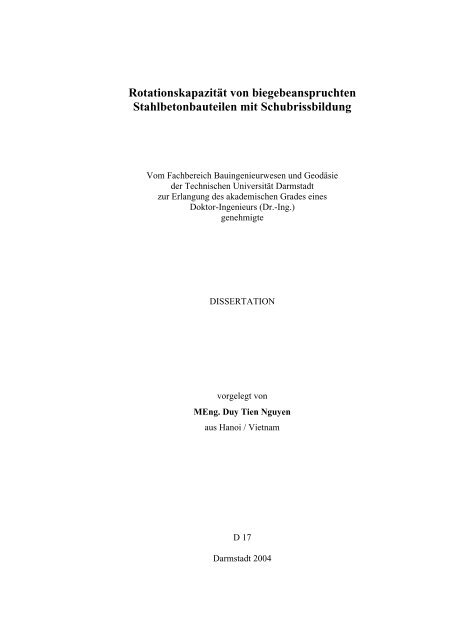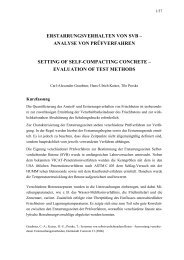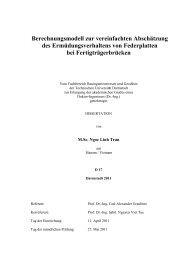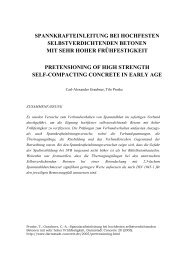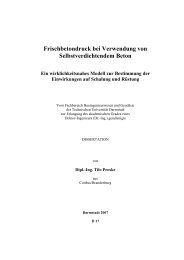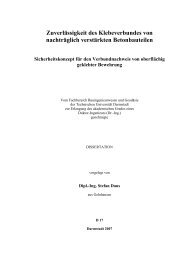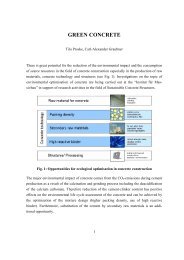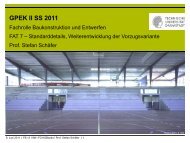Heft 07 - Institut für Massivbau - Technische Universität Darmstadt
Heft 07 - Institut für Massivbau - Technische Universität Darmstadt
Heft 07 - Institut für Massivbau - Technische Universität Darmstadt
Create successful ePaper yourself
Turn your PDF publications into a flip-book with our unique Google optimized e-Paper software.
Rotationskapazität von biegebeanspruchten<br />
Stahlbetonbauteilen mit Schubrissbildung<br />
Vom Fachbereich Bauingenieurwesen und Geodäsie<br />
der <strong>Technische</strong>n Universität <strong>Darmstadt</strong><br />
zur Erlangung des akademischen Grades eines<br />
Doktor-Ingenieurs (Dr.-Ing.)<br />
genehmigte<br />
DISSERTATION<br />
vorgelegt von<br />
MEng. Duy Tien Nguyen<br />
aus Hanoi / Vietnam<br />
D 17<br />
<strong>Darmstadt</strong> 2004
Herausgeber:<br />
Prof. Dr.-Ing. Carl-Alexander Graubner<br />
Anschrift:<br />
<strong>Technische</strong> Universität <strong>Darmstadt</strong><br />
<strong>Institut</strong> für <strong>Massivbau</strong><br />
Petersenstrasse 12<br />
64287 <strong>Darmstadt</strong><br />
http://www.massivbau.tu-darmstadt.de<br />
Nguyen, Duy Tien:<br />
Rotationskapazität von biegebeanspruchten<br />
Stahlbetonbauteilen mit Schubrissbildung<br />
1. Auflage <strong>Darmstadt</strong>, Eigenverlag, <strong>Heft</strong> 7<br />
ISBN 3-9808875-5-3<br />
Gedruckt mit Unterstützung des Deutschen Akademischen Austauschdienstes (DAAD)<br />
Dr. -Ing. Duy Tien Nguyen<br />
Geboren 1974 in Hanoi/Vietnam. Von 1991 bis 1996 Studium des Bauingenieurwesens an<br />
der Hochschule für Verkehrswesen Hanoi (UTC). 1993 und 1994 Preise beim nationalen<br />
Wettbewerb in <strong>Technische</strong> Mechanik und Statik. Seit 1996 Dozent an der Hochschule für<br />
Verkehrswesen Hanoi und freier Mitarbeiter in Highway Engineering Consultants (HECO)<br />
- Transport Engineering Design Incorporation (TEDI) Hanoi. Von 1998 bis 2000<br />
Masterstudiengang in Bauingenieurwesen an der Hochschule für Verkehrswesen Hanoi.<br />
Von 2000 bis 2004 DAAD-Stipendiat zur Promotion in Deutschland. Von 2001 bis 2004<br />
wissenschaftlicher Mitarbeiter von Prof. Dr.-Ing. C.-A. Graubner am <strong>Institut</strong> für<br />
<strong>Massivbau</strong> der <strong>Technische</strong>n Universität <strong>Darmstadt</strong> (TUD).
Rotation Capacity of Reinforced Concrete Members<br />
under Bending and Shear Cracking<br />
Department of Civil Engineering and Geodesy<br />
<strong>Darmstadt</strong> University of Technology<br />
DISSERTATION<br />
MEng. Duy Tien Nguyen<br />
from Hanoi / Vietnam<br />
D 17<br />
<strong>Darmstadt</strong> 2004
Editor:<br />
Prof. Dr.-Ing. Carl-Alexander Graubner<br />
Address:<br />
<strong>Darmstadt</strong> University of Technology<br />
<strong>Institut</strong>e for Concrete Structures, Building Materials and Masonry<br />
Petersenstrasse 12<br />
64287 <strong>Darmstadt</strong><br />
http://www.massivbau.tu-darmstadt.de<br />
Nguyen, Duy Tien:<br />
Rotation Capacity of Reinforced Concrete Members<br />
under Bending and Shear Cracking<br />
1. Edition <strong>Darmstadt</strong>, Own Publishing House, Band 7<br />
ISBN 3-9808875-5-3<br />
Printed with support by the German Academic Exchange Service (DAAD)<br />
Dr. -Ing. Duy Tien Nguyen<br />
born in 1974 in Hanoi/Vietnam. From 1991 to 1996 studying Civil Engineering at the<br />
University of Transport and Communications Hanoi (UTC). 1993 and 1994 Prizes in the<br />
National Competitions in Theoretical Mechanics and Structural Analysis. Since 1996<br />
University Lecturer at the University of Transport and Communications Hanoi and<br />
Collaborator in Highway Engineering Consultants (HECO) - Transport Engineering<br />
Design Incorporation (TEDI) Hanoi. From 1998 to 2000 Master Course in Civil<br />
Engineering at the University of Transport and Communications Hanoi. From 2000 to<br />
2004 DAAD-Scholarship Holder for Doctoral Research in Germany. From 2001 to 2004<br />
Scientific Assistant of Prof. Dr.-Ing. C.-A. Graubner at the <strong>Institut</strong>e for Concrete<br />
Structures, Building Materials and Masonry, <strong>Darmstadt</strong> University of Technology (TUD).
Vorwort<br />
Die vorliegende Arbeit entstand in den Jahren 2002 bis 2004 während meiner Zeit als<br />
Stipendiat des Deutschen Akademischen Austauschdienstes (DAAD) und<br />
wissenschaftlicher Mitarbeiter am <strong>Institut</strong> für <strong>Massivbau</strong> der <strong>Technische</strong>n Universität<br />
<strong>Darmstadt</strong>.<br />
Herrn Prof. Dr.-Ing. Carl-Alexander Graubner danke ich sehr herzlich für das mir<br />
entgegengebrachte Vertrauen, für die vielfältigen Anregungen und Unterstützungen über<br />
vielen Jahren. Seine stete Bereitschaft zur Diskussion mit einem offenen und kritischkonstruktiven<br />
Verhältnis war mir eine sehr wertvolle Hilfe.<br />
Herrn Prof. Dr.-Ing. habil. Nguyen Viet Tue danke ich ganz besonders für seine stete<br />
Diskussionsbereitschaft und für die Übernahme des Korreferates.<br />
Meinen Kollegen bin ich für das Korrekturlesen des Manuskripts und das freundschaftliche<br />
Verhältnis sehr dankbar, das meine Tätigkeit am <strong>Institut</strong> für <strong>Massivbau</strong> zu einer<br />
unvergesslichen Zeit werden ließ. Herrn Dr.-Ing. Michael Six danke ich herzlich für die<br />
fachliche Unterstützung in Anfangszeiten im <strong>Institut</strong>. Für die vielfältigen Unterstützungen<br />
während meiner Zeit im <strong>Institut</strong> gilt hier mein besonderer Dank Frau Sylvia Steinmetz,<br />
Herrn Dr.-Ing. Holger Schmidt, Herrn Dr.-Ing. Andreas Bachmann, Herrn Dipl.-Ing.<br />
Christian Glock und Herrn Dipl.-Ing. Tilo Proske.<br />
Dem Deutschen Akademischen Austauschdienst (DAAD) danke ich für die finanzielle<br />
Unterstützung während meines Aufenthalts in Deutschland und bei der Veröffentlichung<br />
dieser Arbeit.<br />
Meinen Eltern und meinen Freunden in Deutschland bin ich sehr dankbar für die<br />
Anregungen und Unterstützungen während meines Aufenthalts in Deutschland.<br />
Meiner lieben Frau Cam Tu sowie meinen Kindern Cam Ha und Duy Khoi danke ich ganz<br />
besonders herzlich für ihr Verständnis und ihre Geduld, wodurch sie mir die Anfertigung<br />
der vorliegenden Arbeit ermöglichten.<br />
Duy Tien Nguyen<br />
Referent:<br />
Prof. Dr.-Ing. Carl-Alexander Graubner<br />
Korreferent:<br />
Prof. Dr.-Ing. habil. Nguyen Viet Tue<br />
Tag der Einreichung: 29. Juni 2004<br />
Tag der mündlichen Prüfung: 01. Oktober 2004
Summary<br />
The plastic rotation capacity of a reinforced concrete member is a decisive influence factor<br />
for the redistribution of internal forces in statically indeterminate reinforced concrete<br />
beams. The value of the plastic rotation is dependent on many influence factors such as<br />
material properties, cross section and system geometry. The formation of shear cracks in<br />
the member results in a higher plastic rotation due to the truss action. The influence of<br />
shear cracking on the plastic rotation occurs mostly in discontinuity regions, in which a<br />
multiaxial state of stress dominates and as a rule it is considered through a shifting of the<br />
tensile force. In case of earlier failure due to shear the plastic rotation decreases.<br />
According to Eurocode 2, Appendix 2 the allowable plastic rotation of a reinforced<br />
concrete hinge is given only depending on the ductility class of the steel and the neutral<br />
axis depth factor at ultimate state x d /d. Other influences like the concrete ultimate<br />
compressive strain or the shear slenderness are not taken into account. According to Model<br />
Code 90 as well as to DIN 1045-1 the influence due to shear cracking on the plastic<br />
rotation is partly considered. The influence of the stirrup ratio on the plastic rotation is not<br />
provided.<br />
In this dissertation a new approach based on the truss analogy for the determination of<br />
plastic rotation of reinforced concrete members under bending and shear cracking in case<br />
of concrete failure in the compression zone is developed. The plastic rotation due to<br />
bending and shear cracking is determined through the deformation of individual<br />
components of the strut-and-tie model. The material models for concrete and steel are<br />
modified in a way that through the deformation of the truss components the influences of<br />
cracking and multiaxial state of stress on the deformation of the structural member are<br />
covered. Therefore a new simplified material model for concrete is proposed, which<br />
considers the confining effects of hoops depending on the concrete grade and the stirrup<br />
ratio and is based on the relative flexural capacity of the compression zone. A material<br />
model for the stirrups is set up taking into account the tension stiffening effect between<br />
diagonal cracks. For this purpose a new proposal for the average spacing of diagonal<br />
cracks at stabilized crack pattern is developed, which shows a good agreement with the test<br />
results. The influences of the state of deformation in the concrete web on the deformation<br />
of the structural member are considered through different reduction factors for the effective<br />
strength of the concrete struts. The verification of the model shows a good agreement of
the calculation with the test results, especially for members with sufficient reinforcement<br />
and stirrup ratios.<br />
The parameter study with the developed model has shown, that in case of concrete failure<br />
the reinforcement ratio and the concrete ultimate compressive strain are the main<br />
influences on the plastic rotation of the reinforced concrete hinge. The influence of shear<br />
cracking on the plastic rotation is apparently greater for members of smaller shear<br />
slenderness. The steel properties have thereby less effect on the plastic deformation then in<br />
case of steel failure, where the tension stiffening effect plays an important role to the<br />
deformation of the structural member. According to this study the portion due to<br />
deformation of the stirrups and concrete struts can be neglected. The stirrup ratio has<br />
however an apparent effect on the concrete ultimate compressive strain and therefore on<br />
the portion due to bending as well as on the total plastic rotation, especially for members<br />
with small reinforcement ratio. The influence of the width of the loading plate is also of<br />
importance.<br />
Based on the results of the parameter study a proposal for the determination of the plastic<br />
rotation capacity of reinforced concrete members in case of concrete failure with the<br />
influence of shear cracking taken into account is made, in which influences of the main<br />
parameters (material properties, cross section and system geometry) are regarded. The<br />
influence of the shear slenderness on the portion due to bending and shear cracking is<br />
covered separately. Influences of the confining effect of hoops and of the tension stiffening<br />
effect as well as of the width of the loading plate are also considered. The allowable plastic<br />
rotation capacity is given for different neutral axis depth factor x/d. A comparison with<br />
other proposals has shown, that the stirrup ratio according to the proposal has an apparent<br />
effect on the plastic rotation. The influence of stirrups on the ductility of reinforced<br />
concrete members is of significant importance and therefore should be covered in the<br />
standards. Further researches on the influence of the scale effect and for smaller shear<br />
slenderness are necessary in order to take into account the effect of tied-arch behaviour<br />
under shear force on the rotation of structural members.
Inhaltsverzeichnis<br />
Inhaltsverzeichnis<br />
Verwendete Zeichen und Abkürzungen.................................................................................1<br />
1 Einleitung..................................................................................................................9<br />
1.1 Problemstellung .........................................................................................................9<br />
1.2 Zielsetzung...............................................................................................................11<br />
1.3 Vorgehensweise .......................................................................................................12<br />
2 Stand der Technik..................................................................................................15<br />
2.1 Materialmodelle für Beton .......................................................................................15<br />
2.1.1 Modelle für Beton unter einachsiger Druckbeanspruchung.........................15<br />
2.1.2 Modelle für Beton unter einachsiger Zugbeanspruchung ............................19<br />
2.1.3 Modelle für Beton unter mehrachsiger Beanspruchung...............................20<br />
2.1.4 Modelle für Beton mit Umschließungseffekt der Bügelbewehrung ............21<br />
2.1.5 Modelle für Beton unter Druckbeanspruchung und gleichzeitig<br />
wirkender Querzugbeanspruchung der Bewehrung .....................................29<br />
2.2 Materialmodelle für Stahl ........................................................................................35<br />
2.2.1 Modelle für Stahl unter Zug- und Druckbeanspruchung .............................35<br />
2.2.2 Modelle für Stahl mit Berücksichtigung der Mitwirkung des Betons<br />
auf Zug zwischen den Rissen (Zugversteifungseffekt) ................................38<br />
2.3 Ansätze zur Ermittlung der Schrägrissabstände.......................................................44<br />
2.4 Modelle zur Beschreibung des Tragverhaltens von Stahlbetonbauteilen unter<br />
Biegung mit Querkraft .............................................................................................46<br />
2.4.1 Allgemeines..................................................................................................46<br />
2.4.2 Klassisches Fachwerkmodell .......................................................................46<br />
2.4.3 Erweitertes Fachwerkmodell........................................................................47<br />
2.4.4 Fachwerkmodell mit Reibungsanteil............................................................48<br />
2.4.5 Modell auf Grundlage der Plastizitätstheorie...............................................49<br />
2.4.6 FE-Modelle...................................................................................................50<br />
I
Inhaltsverzeichnis<br />
2.4.6 FE-Modelle...................................................................................................50<br />
2.5 Modelle zur Ermittlung der plastischen Rotation ....................................................52<br />
2.5.1 Allgemeines..................................................................................................52<br />
2.5.2 Plastische Rotation infolge Biegung ............................................................53<br />
2.5.3 Plastische Rotation infolge Biegung mit Schubrissbildung .........................60<br />
2.6 Ansätze zur Ermittlung der plastischen Rotationskapazität.....................................66<br />
2.6.1 Beschreibung der Ansätze............................................................................66<br />
2.6.2 Vergleich der Ansätze hinsichtlich des Einflusses der Schubschlankheit ...70<br />
3 Ein Modell zur Ermittlung der plastischen Rotation von Stahlbetonbauteilen<br />
infolge Biegung mit Schubrissbildung..................................................................73<br />
3.1 Vorbemerkung..........................................................................................................73<br />
3.2 Modellierung der Materialeigenschaften .................................................................73<br />
3.2.1 Allgemeines..................................................................................................73<br />
3.2.2 Vorschlag für ein Werkstoffgesetz von Beton in der Biegedruckzone<br />
mit Umschließungseffekt der Bügelbewehrung...........................................74<br />
3.2.3 Vorschlag zur Ermittlung der mittleren Schrägrissabstände........................78<br />
3.2.4 Tragwirkung der Bügelbewehrung unter Berücksichtigung der<br />
Mitwirkung des Betons auf Zug zwischen den Schrägrissen.......................80<br />
3.3 Modellierung des Tragverhaltens.............................................................................83<br />
3.3.1 Überblick......................................................................................................83<br />
3.3.2 Modellierung des Zuggurtes.........................................................................85<br />
3.3.3 Modellierung des Druckgurtes .....................................................................85<br />
3.3.4 Modellierung der Zugstreben .......................................................................87<br />
3.3.5 Modellierung der Druckstreben ...................................................................87<br />
3.4 Ermittlung der Rotationsanteile ...............................................................................88<br />
3.5 Verifikation des entwickelten Modells ....................................................................89<br />
3.5.1 Allgemeines..................................................................................................89<br />
3.5.2 Versuche von De Cossio ..............................................................................90<br />
3.5.3 Versuche von Sampaio.................................................................................91<br />
3.5.4 Versuche von Eifler/ Plauk ..........................................................................91<br />
3.5.5 Folgerungen aus der Verifikation des Modells ............................................93<br />
II
Inhaltsverzeichnis<br />
4 Parameterstudie der maßgebenden Einflussgrößen...........................................95<br />
4.1 Eingangswerte für die Parameterstudie....................................................................95<br />
4.2 Einfluss des Bewehrungsgrades...............................................................................96<br />
4.3 Einfluss der Schubschlankheit .................................................................................98<br />
4.4 Einfluss der Stahleigenschaften .............................................................................100<br />
4.5 Einfluss der Betonbruchstauchung.........................................................................101<br />
4.6 Einfluss des Bügelbewehrungsgrades....................................................................102<br />
4.7 Einfluss der Lastplattenbreite.................................................................................104<br />
4.8 Einfluss des Verformungszustands der Betonstege ...............................................105<br />
5 Näherungsansatz zur Ermittlung der plastischen Rotationskapazität von<br />
Stahlbetonbauteilen .............................................................................................1<strong>07</strong><br />
5.1 Näherungsansatz mit Berücksichtigung des Einflusses der Schubrissbildung<br />
auf die plastische Rotationskapazität .....................................................................1<strong>07</strong><br />
5.2 Vergleich mit anderen Ansätzen ............................................................................110<br />
6 Zusammenfassung................................................................................................113<br />
7 Literaturverzeichnis.............................................................................................117<br />
Dissertationsreihe<br />
III


